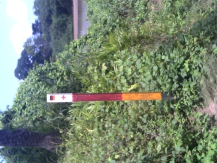4.2.4.7. Anticipative measures of
flood occurrence
The anticipative measures play a great role in the reduction of
flood impacts. The field survey reveals some anticipative measures used by the
population to predict the occurrence of flood. The population combines sign
post markers to control the level of water with local indicators of flooding
(massive presence of ants coming out from ground, and snail climbing trees,
transport of mud, presence of hippopotamus and some type of bird so called
"Tolem" in local language) to anticipate the occurrence of flood. The majority
of the respondents of the total sample (82.8%) reported they are aware of
anticipative measures such as local indicators (78.7%) and sign post marking
possible flooding levels (4.5%)
Low level
Medium level
High level

Photo 7: Implantation of Sign post marking possible
flooding levels
(Early Warning system)
4.2.4.8. Training on flood hazard
management
In terms of training on flood hazard management, 82.8% of the
total respondents said they have received some training on flood hazard
management while, 14% have never received any training . Of those who have some
training, 1.8% indicated they received information on how to control river
water level, 20% reported they received information on hygiene and water
purification measures, 12.21% reported they received information on local
indicators and a small number 3.1% said they were informed on evacuation
areas.
4.2.4.9. Household recovery time and positive effects of
flood on household
The majority of respondents (36.2%) said it takes long time for
them to recover from flood disasters, while 24.9% reported they recover quick
from flood disasters. 75.11% of respondents of the total sample said flood had
no positive effects on their household while 24.9% reported flood had some
positive effects on them. Of all those who reported having experienced positive
effect of flood, 11.31% said their farmlands become more fertile after flood,
7.2 % said they experienced increase of crop yield after flood, 4.07% said they
were able to practice garden activity after flood because the soil become
suitable for such activity and a small number 2.3% said they experienced
increase in fish population, which is good for fishing activity.
4.2.5 Household adaptation options
4.2.5.1 Household's perception of Government and NGOs
role in flood management
The perception of households on the role of Government and NGOs
in flood management was assessed, based on the three phases of disaster
management cycle. The majority (15.83%) of the total respondents interviewed
indicated that government and non government organisations should increase
awareness and educate people about the causes, risks and warning signs
of floods; 11.31% said government and NGOs should build dams
and reservoirs or dikes and levees, and health centres. Others
reported that government and non government organisations should build
retaining ponds, flood channels, safe heaven places, construct roads,
distribute boats; install more sign posts marking possible flooding levels in
the community, plant trees along the river bank and control of Nangbeto dam
opening, as mitigation and preparedness measures to control flood disasters. As
response measures during flood, the majority (54.30%) of respondents reported
that government and NGOs should assist the affected communities with food and
non-food -items, however 36.20% and 9.50% said the government and NGOs should
take appropriate measures to evacuate affected people in the
safe havens and provide health assistance. 52.03% respondents of the total
sample reported government and NGOs should provide seeds, fertilizers and
animals; 13.57% suggested assisting people in returning to their home and
distribution of building materials while 11.31% said government and NGOS should
provide advice and training to flood victims and 9.50% proposed to assist
affected people with financial support for their recovery after floods.
| 


